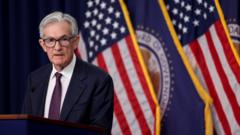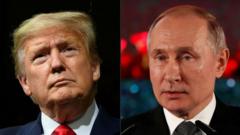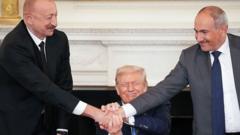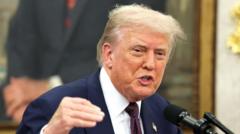The Federal Reserve decided to keep its key interest rate unchanged, remaining at 4.3% as predictions about the economy's future appear less optimistic. Officials cite uncertainty from tariffs and economic policies as reasons for their cautious stance, marking a continuation of their wait-and-see approach amidst rising inflation concerns.
Federal Reserve Maintains Steady Interest Rates Amid Economic Uncertainty

Federal Reserve Maintains Steady Interest Rates Amid Economic Uncertainty
Despite turbulent policy changes, the Federal Reserve opts to hold interest rates steady for the fourth consecutive time.
In a context of evolving economic landscapes, the Federal Reserve's decision to hold its interest rates steady reflects a careful balancing act amidst mounting external pressures. On Wednesday, the central bank announced it would keep its benchmark lending rate steady at 4.3%, a figure that has endured since December. This marks the fourth consecutive decision for unchanged rates, even as forecast conditions for U.S. economic growth appear to be deteriorating.
Current estimations from Fed policymakers suggest a slowdown in growth expected at just 1.4% this year, down from previously anticipated expectations of 1.7%. Additionally, forecasts for inflation have risen to 3%, surpassing earlier predictions of 2.7%. A rise in the unemployment rate to 4.5% is also anticipated. These decisions and projections come in the wake of ongoing tariff-related policy adjustments which have disrupted the economic environment.
President Donald Trump has vocalized his calls for the Fed to initiate cuts to interest rates, insisting that issues causing turbulence have since waned. However, central bank officials insist their commitment lies in data-driven decision-making, independent from external political pressures. In light of this, they have expressed a desire for more clarity on how tariffs and other policies could influence the economy before considering any rate cuts.
Tesla Stell, an investment manager, commented on the implications of Trump's criticism of Fed Chair Jerome Powell, implying the President may be in a complex predicament as the Fed maintains its cautious approach. With the Fed's interest rate decisions shaping the economic borrowing landscape, homeowners and businesses could feel lingering effects of these strategically held rates.
At present, the 4.3% benchmark rate stands notably higher than the range witnessed from 2008 to 2022, but is still approximately one percentage point lower than rates from last year. With central banks around the globe adjusting their rates, the Fed remains steadfast in its strategy while holding the economy's future in careful consideration.
Current estimations from Fed policymakers suggest a slowdown in growth expected at just 1.4% this year, down from previously anticipated expectations of 1.7%. Additionally, forecasts for inflation have risen to 3%, surpassing earlier predictions of 2.7%. A rise in the unemployment rate to 4.5% is also anticipated. These decisions and projections come in the wake of ongoing tariff-related policy adjustments which have disrupted the economic environment.
President Donald Trump has vocalized his calls for the Fed to initiate cuts to interest rates, insisting that issues causing turbulence have since waned. However, central bank officials insist their commitment lies in data-driven decision-making, independent from external political pressures. In light of this, they have expressed a desire for more clarity on how tariffs and other policies could influence the economy before considering any rate cuts.
Tesla Stell, an investment manager, commented on the implications of Trump's criticism of Fed Chair Jerome Powell, implying the President may be in a complex predicament as the Fed maintains its cautious approach. With the Fed's interest rate decisions shaping the economic borrowing landscape, homeowners and businesses could feel lingering effects of these strategically held rates.
At present, the 4.3% benchmark rate stands notably higher than the range witnessed from 2008 to 2022, but is still approximately one percentage point lower than rates from last year. With central banks around the globe adjusting their rates, the Fed remains steadfast in its strategy while holding the economy's future in careful consideration.





















